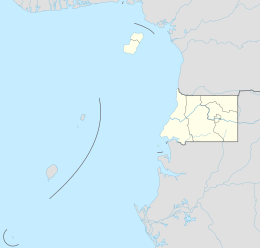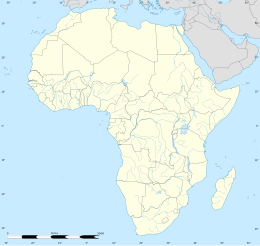This article needs additional citations for verification. (June 2022) |
Native name: Ëtulá a Ëri (Bube) | |
|---|---|
 Map of Bioko | |
| Etymology | Named for Cristino Seriche Bioko |
| Geography | |
| Location | Gulf of Guinea |
| Coordinates | 3°30′N 8°42′E / 3.500°N 8.700°E |
| Archipelago | Cameroon line |
| Area | 2,017 km2 (779 sq mi) |
| Length | 70 km (43 mi) |
| Width | 32 km (19.9 mi) |
| Highest elevation | 3,012 m (9882 ft) |
| Highest point | Pico Basile |
| Administration | |
Equatorial Guinea | |
| Region | Insular Region |
| Provinces | Bioko Norte and Bioko Sur |
| Largest settlement | Malabo (pop. 297,000 (2019 estimate)[1]) |
| Demographics | |
| Population | 335,048 (2015 Census) |
| Pop. density | 165.8/km2 (429.4/sq mi) |
| Languages | Equatoguinean Spanish, Pichinglis, Bube |
| Ethnic groups | Bubi (58%), Fang (16%), Fernandino (12%), Igbo (7%) (2002)[2] |

Bioko (/biːˈoʊkoʊ/;[3] Spanish: [biˈoko] , historically Fernando Po, Spanish: [feɾˈnando ˈpo] ; Bube: Ëtulá a Ëri) is an island of Equatorial Guinea. It is located 32 km (20 mi) south of the coast of Cameroon, and 160 km (99 mi) northwest of the northernmost part of mainland Equatorial Guinea. Malabo, on the north coast of the island, is the capital city of Equatorial Guinea. Its population was 335,048 at the 2015 census[4] and it covers an area of 2,017 km2 (779 sq mi). The island is part of the Cameroon line of volcanoes and is located off the Cameroon coast, in the Bight of Biafra portion of the Gulf of Guinea. Its geology is volcanic; its highest peak is Pico Basile at 3,012 m (9,882 ft).
- ^ "Equatorial Guinea - The World Factbook". cia.gov. 7 June 2018. Retrieved 24 June 2018.
- ^ Minahan, James (2002). Encyclopedia of the Stateless Nations: A-C. Greenwood Publishing Group. p. 330. ISBN 0313321094.
- ^ Room, Adrian (May 30, 2007). The Pronunciation of Placenames: A Worldwide Dictionary. McFarland, Incorporated, Publishers. ISBN 9780786429417 – via Google Books.
- ^ "Anuario Estadístico de Guinea Ecuatorial 2018" (PDF). Instituto Nacional de Estadisticas de Guinea Ecuatorial. Retrieved May 29, 2020.

